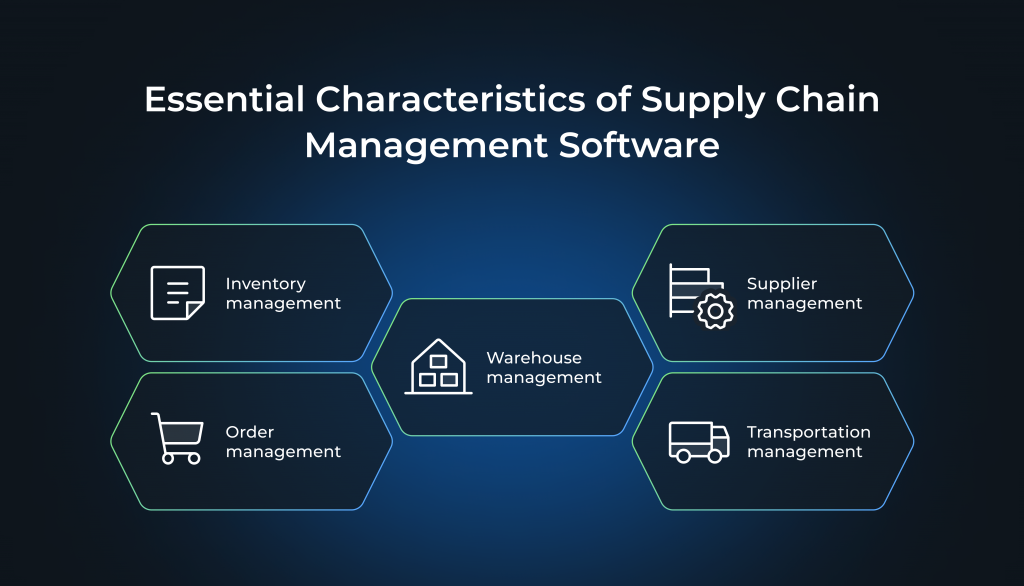Supply chain management software plays a crucial role in optimizing and streamlining the complex processes involved in managing the flow of goods, services, and information in a supply chain. However, before diving into the cost factors associated with developing such software, let’s first understand the basics of supply chain management software.
Understanding the Basics of Supply Chain Management Software
Supply chain management software plays a crucial role in today’s complex business environment. It is a digital solution that facilitates the efficient coordination and management of activities across the supply chain. By leveraging technology, organizations can streamline their operations, reduce costs, and improve overall efficiency.
Defining Supply Chain Management Software
Supply chain management software encompasses various modules and functionalities that help organizations plan, execute, and control the flow of goods, information, and finances from the point of origin to the point of consumption. It acts as a central hub, connecting different stakeholders and enabling seamless collaboration throughout the supply chain.
With supply chain management software, organizations can gain real-time visibility into their supply chain, allowing them to make informed decisions and respond quickly to changes in demand or market conditions. It also helps in automating manual processes, reducing errors, and improving overall productivity.
Key Features of Supply Chain Management Software

Supply chain management software typically includes a wide range of features that cater to the specific needs of organizations. Some of the key features include:
- Inventory management: This feature allows organizations to optimize stock levels and reduce carrying costs. It provides insights into inventory levels, demand patterns, and helps in forecasting future requirements.
- Order management: Automating and streamlining order processing is made possible through this feature. It enables organizations to efficiently manage customer orders, track their status, and ensure timely fulfillment.
- Warehouse management: Efficiently managing warehouse operations is crucial for smooth supply chain operations. This feature helps in optimizing storage space, improving picking and packing processes, and enhancing overall warehouse productivity.
- Transportation management: Optimizing freight movements and reducing transportation costs are made possible through this feature. It enables organizations to plan and execute shipments, track deliveries, and manage carrier relationships.
- Supplier management: Tracking and managing supplier performance is essential for maintaining a reliable supply chain. This feature allows organizations to evaluate supplier performance, monitor delivery schedules, and ensure compliance with contractual agreements.
These features enable organizations to improve supply chain visibility, enhance collaboration, and achieve cost savings. By leveraging supply chain management software, organizations can gain a competitive edge in the market and deliver exceptional customer experiences.
Factors Influencing the Cost of Supply Chain Management Software
While the benefits of supply chain management software are undeniable, it’s important to consider the cost of developing and implementing such a solution. The cost can vary depending on several factors, including:
- Scope and complexity: The scope and complexity of the supply chain management software play a significant role in determining the cost. Solutions that cater to a wide range of industries and have advanced functionalities may require more resources and expertise, thus increasing the cost.
- Integration requirements: Integrating the supply chain management software with existing systems, such as ERP or CRM, can add to the overall cost. The level of integration required and the complexity of the integration process can impact the cost and timeline of the project.
- Customization needs: Organizations may have specific requirements that require customization of the software. Customization can involve additional development efforts, which can increase the cost of the solution.
- Implementation and training: The cost of implementing the supply chain management software and training the users can vary depending on the size of the organization and the complexity of the processes involved. Larger organizations with multiple locations may require more extensive training and support, leading to higher costs.
- Ongoing support and maintenance: After the implementation, ongoing support and maintenance are necessary to ensure the smooth functioning of the supply chain management software. The cost of support and maintenance can vary depending on the level of service required and the complexity of the solution.
Considering these factors and conducting a thorough analysis of the organization’s requirements can help in estimating the cost of supply chain management software accurately. While the initial investment may seem significant, the long-term benefits and cost savings make it a worthwhile investment for organizations looking to optimize their supply chain operations.
Factors Influencing the Cost of Supply Chain Management Software
The cost of supply chain management software is influenced by various factors that determine its complexity, customization requirements, and integration capabilities. Understanding these factors is essential for organizations seeking to implement effective supply chain management solutions. Let’s delve deeper into the key factors that impact the cost of supply chain management software.
Complexity of the Software
The complexity of the supply chain management software significantly affects the development cost. While some organizations may require a basic software solution with limited functionality and modules, others may demand a comprehensive solution with advanced features. For instance, software with artificial intelligence-driven demand forecasting or predictive analytics capabilities can provide valuable insights but may come at a higher cost due to the complexity involved in its development.
Furthermore, the complexity of the software can also be influenced by the size and complexity of the organization’s supply chain. A global enterprise with multiple locations, suppliers, and distribution channels may require a more intricate software solution compared to a small local business.
Customization Requirements
Every organization has unique needs and workflows when it comes to supply chain management. Customization is often required to align the software with these specific requirements. The level of customization needed can impact the development cost.
Extensive customization may involve additional development time and effort, resulting in higher costs. Organizations should carefully evaluate their customization needs and strike a balance between customization and cost-effectiveness. It is crucial to find a software provider that offers flexible customization options without compromising the overall cost of implementation.
Integration with Existing Systems
Integrating the supply chain management software with existing systems, such as enterprise resource planning (ERP) or customer relationship management (CRM) software, is a critical consideration. Seamless data exchange and synchronization between different systems are necessary for efficient supply chain management.
The complexity of integration can affect the development cost. Integrating with legacy systems or outdated software may require additional effort and resources. On the other hand, integrating with modern, cloud-based systems may be more straightforward and cost-effective.
Organizations should assess their existing systems and evaluate the compatibility and integration capabilities of the supply chain management software. It is essential to choose a software solution that can seamlessly integrate with the organization’s current technology infrastructure to avoid unnecessary expenses and complications.
In conclusion, the cost of supply chain management software is influenced by various factors, including complexity, customization requirements, and integration capabilities. Organizations should carefully analyze their specific needs and evaluate the potential costs associated with each factor to make informed decisions when implementing supply chain management software.
The Development Process of Supply Chain Management Software
We at Wesoftyou follow a structured development process for supply chain management software. Our process ensures that the software we deliver is of the highest quality and meets the specific needs of our clients. Let’s take a closer look at the various stages of our development process:
Planning and Designing
During the planning phase, we collaborate closely with our clients to define the project scope, requirements, and goals. We believe that a clear understanding of the client’s needs is crucial for the success of any software development project. Our team of experts conducts thorough research and analysis to gain insights into the client’s industry and specific supply chain management challenges.
Based on the identified needs and industry best practices, we design the software architecture, user interface, and workflow. Our experienced designers work closely with the client to ensure that the design reflects their brand identity and provides a seamless user experience. We pay special attention to usability and accessibility, making sure that the software is intuitive and easy to navigate.
Coding and Implementation
Once the design is finalized, our team of experienced developers begins coding and implementing the software. We follow industry-standard coding practices and use modern technologies to ensure that the software is scalable, robust, and secure. Our developers are well-versed in various programming languages and frameworks, allowing us to choose the most suitable technology stack for each project.
Throughout the coding and implementation phase, we emphasize the importance of clean code and maintainable software. We conduct regular code reviews and adhere to coding standards to ensure that the software is easy to maintain and extend in the future. We also prioritize code reusability, leveraging existing libraries and frameworks to accelerate development and reduce costs.
Testing and Deployment
Thorough testing is a critical part of our development process. We have a dedicated team of quality assurance engineers who conduct comprehensive testing to identify and address any bugs or errors. Our testing process includes functional testing, performance testing, and user acceptance testing.
During functional testing, we verify that the software meets the specified requirements and functions as intended. Performance testing helps us assess the software’s speed, scalability, and resource usage under different workload conditions. User acceptance testing involves real users testing the software to ensure that it meets their expectations and provides a positive user experience.
After successful testing, the software is deployed and made ready for use. We provide support during the deployment phase to ensure a smooth transition and minimize any disruptions to the client’s operations. Our team is available to address any post-deployment issues and provide ongoing maintenance and updates as needed.
In conclusion, our development process for supply chain management software is designed to deliver high-quality, tailored solutions that address our clients’ specific needs. We combine industry best practices, modern technologies, and a focus on usability to create software that streamlines supply chain operations and drives business success.
Hiring a Development Team: In-house vs. Outsourcing
When it comes to developing software or building digital products, one of the key decisions that businesses face is whether to hire an in-house development team or outsource the project to a third-party software development company. Both options have their own set of advantages and disadvantages, and understanding them can help businesses make an informed decision.
Pros and Cons of In-house Development
Hiring an in-house development team provides better control over the development process. With an in-house team, businesses have direct oversight and can closely monitor the progress of the project. This level of control allows for easier collaboration and quicker response times, as any issues or changes can be addressed immediately.
However, it’s important to consider the cost implications of building an in-house development team. Recruitment, salaries, benefits, and infrastructure costs can quickly add up, making it an expensive option for businesses, especially startups or small companies with limited budgets. Moreover, finding and retaining skilled resources can be a challenge, as the demand for talented developers often exceeds the supply.
Pros and Cons of Outsourcing
Outsourcing the development to a reputable software development company like Wesoftyou can offer several benefits. One of the main advantages is access to a pool of experienced professionals who specialize in different technologies and have a proven track record of delivering high-quality projects. This expertise can significantly enhance the development process and ensure the final product meets the required standards.
Cost savings is another key advantage of outsourcing. By partnering with an external development team, businesses can avoid the expenses associated with hiring and maintaining an in-house team. Outsourcing allows for greater flexibility, as businesses can scale their development resources up or down based on their project requirements, without the need for long-term commitments.
Additionally, outsourcing can lead to faster time to market. With an experienced development team, businesses can leverage their expertise and industry knowledge to expedite the development process. This can be particularly beneficial for businesses operating in highly competitive markets where speed is crucial.
However, effective communication and project management are crucial to ensuring successful collaboration with the outsourcing partner. Clear and frequent communication is essential to align expectations, address any concerns, and keep the project on track. Businesses should also invest time in selecting the right outsourcing partner, considering factors such as their reputation, portfolio, and cultural fit.
In conclusion, both in-house development and outsourcing have their own set of pros and cons. Businesses should carefully evaluate their specific needs, budget, and project requirements before making a decision. Whether they choose to build an in-house team or outsource the development, it’s important to prioritize effective communication, collaboration, and quality to achieve successful outcomes.
Ongoing Costs of Supply Chain Management Software
Supply chain management software is a valuable tool for businesses to streamline their operations and improve efficiency. However, it is important to consider the ongoing costs associated with using and maintaining this software. Let’s take a closer look at some of these costs:
Maintenance and Updates
Maintaining and updating the software is essential to keep it running smoothly and to address any evolving business needs. Ongoing maintenance costs include bug fixes, security updates, and software upgrades. These updates are crucial to ensure that the software remains compatible with other systems and to address any vulnerabilities that may arise.
Additionally, software updates often come with new features and functionalities that can further enhance the efficiency of supply chain management processes. However, it’s important to note that implementing these updates may require some downtime and potential retraining of employees, which can add to the overall cost.
Training and Support
Providing training to end-users and ongoing support is crucial to ensure the software is effectively utilized and to address any user queries or issues. Training can be provided by the development team or through user documentation and online resources.
Training sessions can help employees understand how to navigate the software, utilize its features, and maximize its potential. This can lead to increased productivity and a smoother workflow within the organization. Ongoing support is also important to address any technical issues or questions that may arise during day-to-day operations.
Some organizations may choose to have dedicated support personnel or even hire external consultants to provide specialized assistance. While this can incur additional costs, it can also provide peace of mind knowing that there is expert help available when needed.
Software Licensing Fees
Some supply chain management software solutions have licensing fees that organizations need to consider. Licensing fees can vary based on factors such as the number of users, functionality required, and the agreement between the organization and the software vendor.
It is important for businesses to carefully evaluate their needs and budget before selecting a software solution. Understanding the licensing fees and any potential additional costs, such as maintenance and support, can help organizations make an informed decision.
Furthermore, it’s worth noting that some software vendors offer different pricing models, such as annual subscriptions or one-time purchases. Evaluating these options can help businesses find the most cost-effective solution for their specific requirements.
Overall, while supply chain management software can bring significant benefits to businesses, it is important to consider the ongoing costs associated with its use. By factoring in maintenance and updates, training and support, and software licensing fees, organizations can make informed decisions and ensure that the software continues to provide value in the long run.
Cost-Saving Tips for Developing Supply Chain Management Software
Developing supply chain management software can be a complex and costly endeavor. However, there are several strategies that organizations can employ to reduce development costs without compromising on the quality and functionality of the software. In this article, we will explore some cost-saving tips that can help organizations streamline their supply chain management software development process.
Prioritizing Essential Features
One of the most effective ways to save costs during the development of supply chain management software is to prioritize essential features. By identifying the features that align with the organization’s requirements and focusing development efforts on critical functionality, unnecessary and complex features can be avoided. This not only reduces development time but also minimizes the resources required for testing and maintenance.
For example, instead of investing time and resources in developing intricate reporting capabilities that may not be crucial for the organization’s immediate needs, it is more cost-effective to focus on features like inventory management, order tracking, and demand forecasting. By prioritizing essential features, organizations can ensure that their supply chain management software meets their core requirements while keeping development costs in check.
Choosing the Right Development Team
Partnering with a software development company that specializes in supply chain management software development can significantly contribute to cost savings. Companies like Wesoftyou have proven expertise in this domain and can provide access to skilled professionals who are well-versed in industry best practices. By leveraging the knowledge and experience of such development teams, organizations can optimize the development process, reduce costs, and deliver a high-quality solution.
Working with a reputable development team also eliminates the need for extensive training and onboarding, as the developers are already familiar with the intricacies of supply chain management software. This saves both time and money, allowing organizations to focus on other critical aspects of their business.
Planning for Future Scalability
While it is essential to address the immediate needs of the organization, it is equally important to consider future scalability requirements during the initial development phase. Developing a modular and flexible software architecture allows for easier expansion and integration with new technologies or business functionalities, reducing the need for extensive redevelopment in the future.
For instance, incorporating an application programming interface (API) into the software architecture enables seamless integration with other systems, such as enterprise resource planning (ERP) software or customer relationship management (CRM) tools. This future-proofing approach saves costs by eliminating the need for significant modifications or redevelopment when the organization’s requirements evolve over time.
From our experience at Wesoftyou, the cost of developing a supply chain management software solution can range from $50,000 to over $500,000, depending on the complexity, customization requirements, and integration complexity. It is crucial for organizations to carefully evaluate their budget and requirements before embarking on the development journey.
Are you looking to develop a supply chain management software solution tailored to your organization’s needs? Contact us at Wesoftyou for a free consultation or project estimation. Our experienced team will be happy to assist you in achieving your supply chain management goals.
In conclusion, developing supply chain management software requires careful planning and consideration to ensure cost-effectiveness. By prioritizing essential features, choosing the right development team, and planning for future scalability, organizations can save costs without compromising on the quality and functionality of their software.
FAQ
The development timeline depends on various factors, including the complexity of the software, the scope of customization, and the availability of resources. On average, it can take anywhere from three to twelve months.
Yes, our development team at Wesoftyou specializes in seamless integration with various enterprise systems, including ERP and CRM software. We ensure data synchronization and smooth communication between different software solutions.
We offer comprehensive support and maintenance services, including bug fixes, security updates, software upgrades, and training for end-users. Our team is available to assist you and address any software-related queries or issues.
A: Security is one of our top priorities. We follow industry-standard security practices and conduct regular security audits to ensure the software is robust and protected against potential threats.
Contact us today for a free consultation or project estimation. Let us help you streamline your supply chain management processes with our expertise in software development.




















